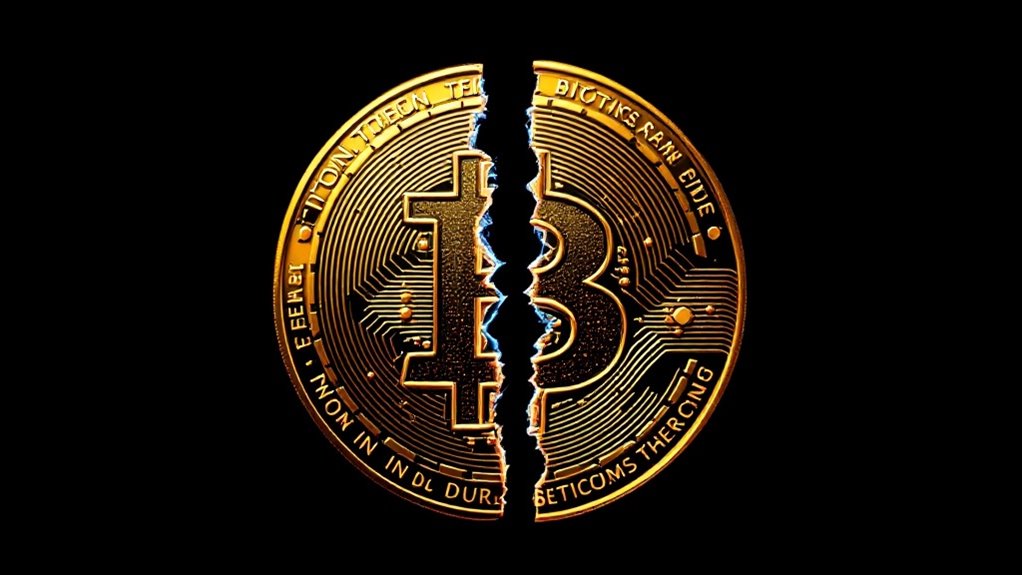Bitcoin halving acts as a built-in mechanism that cuts mining rewards in half every four years, or roughly every 210,000 blocks. This digital ritual has occurred three times since Bitcoin's creation – in 2012, 2016, and 2020 – each time reducing the number of new bitcoins entering circulation. Like clockwork, these events have historically preceded significant price increases, though past performance doesn't guarantee future results. The next halving in April 2024 promises another fascinating chapter in Bitcoin's evolving story.

While traditional financial systems rely on central banks to control money supply, Bitcoin operates on a remarkably different principle known as "halving" – a programmed reduction in the cryptocurrency's production rate that occurs roughly every four years. This elegant mechanism, embedded in Bitcoin's code by its mysterious creator Satoshi Nakamoto, serves as a digital parallel to the natural scarcity of precious metals like gold.
The concept is beautifully simple yet profound in its implications. Every 210,000 blocks, or approximately four years, the reward that Bitcoin miners receive for validating transactions gets cut in half. Like clockwork, this digital pruning has occurred three times already: from 50 bitcoins in 2012, to 25 in 2016, and then to 12.5 in 2020. The next halving, scheduled for April 2024, will reduce the reward to a mere 3.125 bitcoins. The process is primarily facilitated by large mining operations that utilize specialized equipment to solve complex mathematical problems.
This systematic reduction has historically sparked fascinating market dynamics. Following each halving, Bitcoin's price has demonstrated remarkable resilience and growth. The 2012 halving saw the price surge from $12 to $964 within a year, while the 2016 event preceded a rise from $663 to $2,550. After the 2020 halving, Bitcoin reached an unprecedented peak of $69,000, though with its characteristic volatility. The price surged from about $6,910 before the 2020 halving to nearly $10,000 shortly after.
Looking ahead, this mathematical dance will continue until approximately 2140, when the last of the 21 million bitcoins will be mined. The journey presents both challenges and opportunities for the mining community. As block rewards diminish, miners must increasingly rely on transaction fees to maintain profitability. This shifting landscape could reshape the mining industry's structure and economics. Building on earlier concepts like Wei Dai's proposal, Bitcoin's decentralized system has revolutionized digital currency through its innovative use of encryption and digital signatures.
The halving mechanism represents more than just a technical feature – it's a bold experiment in digital monetary policy. Unlike the often-unpredictable decisions of central banks, Bitcoin's supply schedule is transparent and immutable. This programmatic approach to scarcity has captured the imagination of investors and technologists alike, though questions about long-term sustainability remain.
As we approach the fourth halving, the crypto world watches with bated breath, wondering how this digital choreography will continue to influence the future of money.
Frequently Asked Questions
Can Bitcoin Mining Still Be Profitable After Multiple Halvings?
Mining profitability can persist through halvings when Bitcoin's price appreciates, miners optimize operational efficiency, diversify revenue streams, and adapt to technological advancements. Historical data shows sustainable profitability despite reward reductions.
How Does Halving Affect Bitcoin Transaction Fees?
Transaction fees typically increase following halvings as miners seek to compensate for reduced block rewards. The 2024 halving saw fees spike to $128.45, though they later stabilized around $30 per transaction.
What Happens if Miners Quit After a Halving Event?
When miners quit, network hash rate temporarily decreases, causing slower transaction confirmations. However, difficulty adjustment mechanisms automatically rebalance the system, making mining more profitable for remaining operators who gain larger reward shares.
Do Other Cryptocurrencies Undergo Halving Events Like Bitcoin?
Yes, several cryptocurrencies implement halving mechanisms. Litecoin, Bitcoin Cash, and Zcash follow predetermined schedules reducing block rewards periodically. Others like Dash use different reduction models to control token emission over time.
Can the Bitcoin Halving Schedule Be Changed or Modified?
While technically possible through a hard fork, modifying Bitcoin's halving schedule requires widespread network consensus. Due to strong community resistance and technical complexity, such changes are extremely unlikely to be implemented.









